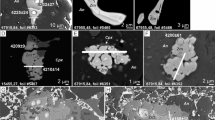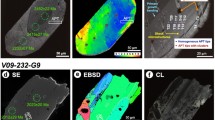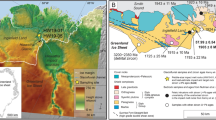Abstract
Zircon (ZrSiO4) is used to study impact structures because it responds to shock loading and unloading in unique, crystallographically controlled manners. One such phenomenon is the transformation of zircon to the high-pressure polymorph, reidite. This study quantifies the geometric and crystallographic orientation relationships between these two phases using naturally shocked zircon grains. Reidite has been characterized in 32 shocked zircon grains (shocked to stages II and III) using a combination of electron backscatter diffraction (EBSD) and focused ion beam cross-sectional imaging techniques. The zircon-bearing clasts were obtained from within suevite breccia from the Nördlingen 1973 borehole, close to the center of the 14.4 Ma Ries impact crater, in Bavaria, Germany. We have determined that multiple sets (up to 4) of reidite lamellae can form in a variety of non-rational habit planes within the parent zircon. However, EBSD mapping demonstrates that all occurrences of lamellar reidite have a consistent interphase misorientation relationship with the host zircon that is characterized by an approximate alignment of a {100}zircon with a {112}reidite and alignment of a {112}zircon with a conjugate {112}reidite. Given the tetragonal symmetry of zircon and reidite, we predict that there are eight possible variants of this interphase relationship for reidite transformation within a single zircon grain. Furthermore, laser Raman mapping of one reidite-bearing grain shows that moderate metamictization can inhibit reidite formation, thereby highlighting that the transformation is controlled by zircon crystallinity. In addition to lamellar reidite, submicrometer-scale granules of reidite were observed in one zircon. The majority of reidite granules have a topotaxial alignment that is similar to the lamellar reidite, with some additional orientation dispersion. We confirm that lamellar reidite likely forms via a deviatoric transformation mechanism in highly crystalline zircon, whereas granular reidite forms via a reconstructive transformation from low-crystallinity ZrSiO4 within the reidite stability field. The results of this study further refine the formation mechanisms and conditions of reidite transformation in naturally shocked zircon.













Similar content being viewed by others
References
Bauberger W, Mielke H, Schmeer D, Stettner G (1974) Petrographische Profildarstellung der Forschungsbohrung Nördlingen 1973 (von Meter 263 an bis zur Endteufe im Maßstab 1:200). Geologica Bavarica 72:33–34
Bohor BF, Betterton WJ, Krogh TE (1993) Impact-shocked zircons: discovery of shock-induced textures reflecting increasing degrees of shock metamorphism. Earth Planet Sci Lett 119:419–424. doi:10.1016/0012-821X(93)90149-4
Cavosie AJ, Erickson TM, Timms NE (2015a) Nanoscale records of ancient shock deformation: reidite (ZrSiO4) in sandstone at the Ordovician Rock Elm impact crater. Geology 43:315–318. doi:10.1130/g36489.1
Cavosie AJ, Erickson TM, Timms NE, Reddy SM, Talavara C, Montalvo SD, Pincus MR, Gibbon RJ, Moser D (2015b) A terrestrial perspective on using ex situ shocked zircons to date lunar impacts. Geology 43:999–1002. doi:10.1130/g37059.1
Cavosie AJ, Timms NE, Erickson TM, Hagerty JJ, Hörz F (2016) Transformations to granular zircon revealed: twinning, reidite, and ZrO2 in shocked zircon from Meteor Crater (Arizona, USA). Geology. doi:10.1130/g38043.1
Chen M, Yin F, Li X, Xie X, Xiao W, Tan D (2013) Natural occurrence of reidite in the Xiuyan crater of China. Meteorit Planet Sci 48:796–805. doi:10.1111/maps.12106
Delaey L (2006) Diffusionless transformations. In: Materials science and technology. Wiley-VCH Verlag GmbH & Co. KGaA, pp 585–654. doi:10.1002/9783527603978.mst0392
Di Vincenzo G, Skála R (2009) 40Ar–39Ar laser dating of tektites from the Cheb Basin (Czech Republic): evidence for coevality with moldavites and influence of the dating standard on the age of the Ries impact. Geochim Cosmochim Acta 73:493–513. doi:10.1016/j.gca.2008.10.002
El Goresy A (1965) Baddeleyite and its significance in impact glasses. J Geophys Res 70:3453–3456. doi:10.1029/JZ070i014p03453
El Goresy A, Dubrovinsky L, Gillet P, Graup G, Chen M (2010) Akaogiite: an ultra-dense polymorph of TiO2 with the baddeleyite-type structure, in shocked garnet gneiss from the Ries Crater, Germany. Am Mineral 95:892–895. doi:10.2138/am.2010.3425
Engelhardt WV, Bertsch W (1969) Shock induced planar deformation structures in quartz from the Ries crater, Germany. Contrib Miner Petrol 20:203–234. doi:10.1007/BF00377477
Erickson TM, Cavosie AJ, Moser DE, Barker IR, Radovan HA (2013a) Correlating planar microstructures in shocked zircon from the Vredefort Dome at multiple scales: crystallographic modeling, external and internal imaging, and EBSD structural analysis. Am Mineral 98:53–65. doi:10.2138/am.2013.4165
Erickson TM, Cavosie AJ, Moser DE, Barker IR, Radovan HA, Wooden J (2013b) Identification and provenance determination of distally transported, Vredefort-derived shocked minerals in the Vaal River, South Africa using SEM and SHRIMP-RG techniques. Geochim Cosmochim Acta 107:170–188. doi:10.1016/j.gca.2012.12.008
Ferrière L, Morrow JR, Amgaa T, Koeberl C (2009) Systematic study of universal-stage measurements of planar deformation features in shocked quartz: implications for statistical significance and representation of results. Meteorit Planet Sci 44:925–940. doi:10.1111/j.1945-5100.2009.tb00778.x
Fiske PS, Nellis WJ, Sinha AK (1999) Shock-induced phase transitions of ZrSiO4, reversion kinetics, and implications for impact heating in terrestrial craters. In: APS, shock compression of condensed matter meeting abstract: 501
Flórez M, Contreras-García J, Recio JM, Marqués M (2009) Quantum-mechanical calculations of zircon to scheelite transition pathways in ZrSiO4. Phys Rev B 79:104101
French BM (1998) Traces of catastrophe: a handbook of shock-metamorphic effects in terrestrial meteorite impact structures. Lunar and Planetary Institute
French BM, Koeberl C (2010) The convincing identification of terrestrial meteorite impact structures: what works, what doesn’t, and why. Earth Sci Rev 98:123–170. doi:10.1016/j.earscirev.2009.10.009
Geisler T, Pidgeon R (2001) Significance of radiation damage on the integral SEM cathodoluminescence intensity of zircon: an experimental annealing study. N Jhb Mineral Monatsh 10:433–445
Glass BP, Liu S (2001) Discovery of high-pressure ZrSiO4 polymorph in naturally occurring shock-metamorphosed zircons. Geology 29:371–373. doi:10.1130/0091-7613(2001)029<0371:dohpzp>2.0.co;2
Glass BP, Liu S, Leavens PB (2002) Reidite: an impact-produced high-pressure polymorph of zircon found in marine sediments. Am Mineral 87:562–565
Goltrant O, Cordier P, Doukhan J-C (1991) Planar deformation features in shocked quartz; a transmission electron microscopy investigation. Earth Planet Sci Lett 106:103–115. doi:10.1016/0012-821X(91)90066-Q
Gucsik A, Koeberl C, Brandstätter F, Libowitzky E, Reimold W (2004a) Cathodoluminescence, electron microscopy, and Raman spectroscopy of experimentally shock metamorphosed zircon crystals and naturally shocked zircon from the ries impact crater. In: Dypvik H, Burchell M, Claeys P (eds) Cratering in marine environments and on ice. Impact studies. Springer, Berlin, pp 281–322
Gucsik A, Zhang M, Koeberl C, Salje EKH, Redfern SAT, Pruneda JM (2004b) Infrared and Raman spectra of ZrSiO4 experimentally shocked at high pressures. Mineral Mag 68:801–811. doi:10.1180/0026461046850220
Hanchar J, Miller C (1993) Zircon zonation patterns as revealed by cathodoluminescence and backscattered electron images: implications for interpretation of complex crustal histories. Chem Geol 110:1–13
Hough RM, Gilmour I, Pillinger CT, Arden JW, Gilkess KWR, Yuan J, Milledge HJ (1995) Diamond and silicon carbide in impact melt rock from the Ries impact crater. Nature 378:41–44
Kaczmarek MA, Reddy SM, Timms NE (2011) Evolution of zircon deformation mechanisms in a shear zone (Lanzo massif, Western-Alps). Lithos 127:414–426. doi:10.1016/j.lithos.2011.09.016
Kamo SL, Krogh T, Glass BP, Liu S (2002) U-Pb Study of Shocked Zircons from the North American Microtektite Layer. In: 33rd Annual LPSC Abstract:1643
Knittle E, Williams Q (1993) High-pressure Raman spectroscopy of ZrSiOoz observation of the zircon to scheelite transition at 300 K. Am Mineral 78:245–252
Krogh T, Davis DW, Corfu F (1984) Precise U-Pb zircon and baddeleyite ages for the sudbury area. In: Pye EG, Naldrett AJ, Giblin PE (eds) The geology and ore deposits of the Sudbury structure, Ontario. Ontario Geological Survey, London, pp 431–447
Krogh TE, Kamo SL, Bohor BF (1993) Fingerprinting the K/T impact site and determining the time of impact by UPb dating of single shocked zircons from distal ejecta. Earth Planet Sci Lett 119:425–429. doi:10.1016/0012-821X(93)90150-8
Kusaba K, Syono Y, Kikuchi M, Fukuoka K (1985) Shock behavior of zircon: phase transition to scheelite structure and decomposition. Earth Planet Sci Lett 72:433–439. doi:10.1016/0012-821X(85)90064-0
Kusaba K, Yagi T, Kikuchi M, Syono Y (1986) Structural considerations on the mechanism of the shock-induced zircon-scheelite transition in ZrSiO4. J Phys Chem Solids 47:675–679. doi:10.1016/0022-3697(86)90082-X
Lang M, Zhang F, Lian J, Trautmann C, Neumann R, Ewing RC (2008) Irradiation-induced stabilization of zircon (ZrSiO4) at high pressure. Earth Planet Sci Lett 269:291–295. doi:10.1016/j.epsl.2008.02.027
Langenhorst F, Deutsch A (2012) Shock metamorphism of minerals. Elements 8:31–36. doi:10.2113/gselements.8.1.31
Leroux H, Reimold WU, Koeberl C, Hornemann U, Doukhan JC (1999) Experimental shock deformation in zircon: a transmission electron microscopic study. Earth Planet Sci Lett 169:291–301. doi:10.1016/S0012-821X(99)00082-5
Malone L (2009) Characterization of shock metamorphosed ZrSiO4 in the Chesapeake Bay impact crater. In: AAPG, Atlantic Universities Geologic conference 45:153
Malone L, Boonsue S, Spray J, Wittmann A (2010) Zircon-reidite relations in breccias from the Chesapeake Bay impact structure. In: 41st annual LPSC abstract: 2286
Marqués M, Contreras-García J, Flórez M, Recio JM (2008) On the mechanism of the zircon-reidite pressure induced transformation. J Phys Chem Solids 69:2277–2280. doi:10.1016/j.jpcs.2008.04.016
Mashimo T, Nagayama K, Sawaoka A (1983) Shock compression of zirconia ZrO2 and zircon ZrSiO4 in the pressure range up to 150 GPa. Phys Chem Minerals 9:237–247. doi:10.1007/BF00309573
Melosh J (1989) Impact cratering: a geologic process. Oxford Monographs on Geology and Geophysics, Oxford
Morozova I (2015) Strength study of zircon under high pressure. Thesis, The University of Western Ontario
Moser DE, Cupelli CL, Barker IR, Flowers RM, Bowman JR, Wooden J, Hart JR (2011) New zircon shock phenomena and their use for dating and reconstruction of large impact structures revealed by electron nanobeam (EBSD, CL, EDS) and isotopic U-Pb and (U–Th)/He analysis of the Vredefort dome. Can J Earth Sci 48:117–139. doi:10.1139/e11-011
Nasdala L, Wenzel M, Vavra G, Irmer G, Wenzel T, Kober B (2001) Metamictisation of natural zircon: accumulation versus thermal annealing of radioactivity-induced damage. Contrib Miner Petrol 141:125–144. doi:10.1007/s004100000235
Ono S, Funakoshi K, Nakajima Y, Tange Y, Katsura T (2004) Phase transition of zircon at high P-T conditions. Contrib Miner Petrol 147:505–509. doi:10.1007/s00410-004-0570-6
Poelchau MH, Kenkmann T (2011) Feather features: A low-shock-pressure indicator in quartz. J Geophys Res 116:B02201. doi:10.1029/2010jb007803
Pohl J, Poschlod K, Reimold WU, Meyer C, Jacob J (2010) Ries crater, Germany: the Enkingen magnetic anomaly and associated drill core SUBO 18. Geol Soc Am Spec Pap 465:141–163. doi:10.1130/2010.2465(10)
Reddy SM, Johnson TE, Fischer S, Rickard WDA, Taylor RJM (2015) Precambrian reidite discovered in shocked zircon from the Stac Fada impactite, Scotland. Geology 43:899–902. doi:10.1130/g37066.1
Reddy SM, van Riessen A, Saxey DW, Johnson TE, Rickard WAD, Fougerouse D, Fischer S, Prosa TJ, Rice KP, Reinhard DA, Chen Y, Olson D (2016) Mechanisms of deformation-induced trace element migration in zircon resolved by atom probe and correlative microscopy. Geochim Cosmochim Acta 195:158–170. doi:10.1016/j.gca.2016.09.019
Reid AF, Ringwood AE (1969) Newly observed high pressure transformations in Mn3O4, CaAl2O4, and ZrSiO4. Earth Planet Sci Lett 6:205–208
Reimold WU, Hansen BK, Jacob J, Artemieva NA, Wunnemann K, Meyer C (2011) Petrography of the impact breccias of the Enkingen (SUBO 18) drill core, southern Ries crater, Germany: new estimate of impact melt volume. Geol Soc Am Bull 124:104–132. doi:10.1130/b30470.1
Schmidt-Kaler H (2004) Geologische Übersichtskarte des Meteoritenkraters Nördlinger Ries: mit Kurzerläuterungen. Bayerisches Geologisches Landesamt
Schmieder M, Tohver E, Jourdan F, Denyszyn SW, Haines PW (2015) Zircons from the Acraman impact melt rock (South Australia): shock metamorphism, U-Pb and 40Ar/39Ar systematics, and implications for the isotopic dating of impact events. Geochim Cosmochim Acta 161:71–100. doi:10.1016/j.gca.2015.04.021
Shoemaker EM, Chao ECT (1961) New evidence for the impact origin of the Ries Basin, Bavaria, Germany. J Geophys Res 66:3371–3378. doi:10.1029/JZ066i010p03371
Singleton AC, Osinski GR, Shieh SR (2015) Microscopic effects of shock metamorphism in zircons from the Haughton impact structure, Canada. Geol Soc Am Spec Pap 518:135–148. doi:10.1130/2015.2518(09)
Smirnov MB, Mirgorodsky AP, Kazimirov VY, Guinebretière R (2008) Bond-switching mechanism for the zircon-scheelite phase transition. Phys Rev B 78:094109
Stähle V, Altherr R, Koch M, Nasdala L (2007) Shock-induced growth and metastability of stishovite and coesite in lithic clasts from suevite of the Ries impact crater (Germany). Contrib Miner Petrol 155:457–472. doi:10.1007/s00410-007-0252-2
Stöffler D (1971a) Coesite and stishovite in shocked crystalline rocks. J Geophys Res 76:5474–5488. doi:10.1029/JB076i023p05474
Stöffler D (1971b) Progressive metamorphism and classification of shocked and brecciated crystalline rocks at impact craters. J Geophys Res 76:5541–5551. doi:10.1029/JB076i023p05541
Stöffler D (1977) Research drilling Nördlingen 1973: polymict breccias, crater basement, and cratering model of the Ries imapct structure. Geol Bavarica 75:443–458
Stöffler D, Langenhorst F (1994) Shock metamorphism of quartz in nature and experiment: I. Basic observation and theory*. Meteoritics 29:155–181. doi:10.1111/j.1945-5100.1994.tb00670.x
Stöffler D, Artemieva NA, Wünnemann K, Reimold WU, Jacob J, Hansen BK, Summerson IAT (2013) Ries crater and suevite revisited-observations and modeling part I: observations. Meteorit Planet Sci 48:515–589. doi:10.1111/maps.12086
Sturm S, Wulf G, Jung D, Kenkmann T (2013) The Ries impact, a double-layer rampart crater on Earth. Geology 41:531–534. doi:10.1130/g33934.1
Thomson OA, Cavosie AJ, Moser DE, Barker I, Radovan HA, French BM (2014) Preservation of detrital shocked minerals derived from the 1.85 Ga Sudbury impact structure in modern alluvium and Holocene glacial deposits. Geol Soc Am Bull 126:720–737. doi:10.1130/b30958.1
Timms NE, Erickson TM, Pearce MA, Cavosie AJ, Schmieder M, Tohver E, Reddy SM, Zanetti MR, Nemchin AA, Wittmann A (2017) A pressure-temperature phase diagram for zircon at extreme conditions. Earth-Sci Rev 165:185–202. doi:10.1016/j.earscirev.2016.12.008
Timms NE, Reddy SM, Healy D, Nemchin AA, Grange ML, Pidgeon RT, Hart R (2012) Resolution of impact-related microstructures in lunar zircon: a shock-deformation mechanism map. Meteorit Planet Sci 47:120–141. doi:10.1111/j.1945-5100.2011.01316.x
Turner D, Langenhorst F, Pollok K (2014) Martensitic mechanism of the zircon-to-reidite transformation. In: 77th annual meeting of the Meteoritical Society Abstract: 5411
van Westrenen W, Frank MR, Hanchar JM, Fei Y, Finch RJ, Zha C-S (2004) In situ determination of the compressibility of synthetic pure zircon (ZrSiO4) and the onset of the zircon-reidite phase transition. Am Mineral 89:197–203
Whitehead J, Spray JG, Grieve RAF (2002) Origin of “toasted” quartz in terrestrial impact structures. Geology 30:431–434. doi:10.1130/0091-7613(2002)030<0431:ootqit>2.0.co;2
Wittmann A, Kenkmann T, Schmitt RT, Stöffler D (2006) Shock-metamorphosed zircon in terrestrial impact craters. Meteorit Planet Sci 41:433–454. doi:10.1111/j.1945-5100.2006.tb00472.x
Wittmann A, Reimold WU, Schmitt RT, Hecht L, Kenkmann T (2009) The record of ground zero in the Chesapeake Bay impact crater—Suevites and related rocks. Geol Soc Am Spec Pap 458:349–376. doi:10.1130/2009.2458(16)
Yue B, Hong F, Merkel S, Tan D, Yan J, Chen B, Mao H-K (2016) Deformation behavior across the zircon-scheelite phase transition. Phys Rev Lett 117:135701
Acknowledgements
We would like to thank Gisele Pösges, Deputy Director of the Ries Crater Museum, for supplying the samples. TME acknowledges financial support from a Curtin International Postgraduate Research Scholarship from Curtin University Office of Research and Development. AJC acknowledges support from the US National Science Foundation (EAR-1145118) and the NASA Astrobiology program. MAP was supported by a CSIRO Office of the Chief Executive Postdoctoral Fellowship. Analytical costs were supported by the ARC Core to Crust Fluid System Centre of Excellence. The ARC (LE130100053), Curtin University, University of Western Australia, and CSIRO are acknowledged for funding the Tescan Mira3 FEG-SEM housed in the John de Laeter Centre’s Microscopy & Microanalysis Facility at Curtin University. The Tescan Lyra3 FIB-SEM is part of the Australian Resource Characterisation Facility (ARCF), under the auspices of the National Resource Sciences Precinct (NRSP)—a collaboration between CSIRO, Curtin University and The University of Western Australia—and is supported by the Science and Industry Endowment Fund. We would like to thank Gordon Moore for thorough editorial handling and two anonymous reviewers for their significant improvements to the manuscript.
Author information
Authors and Affiliations
Corresponding author
Additional information
Communicated by Gordon Moore.
Electronic supplementary material
Below is the link to the electronic supplementary material.
Rights and permissions
About this article
Cite this article
Erickson, T.M., Pearce, M.A., Reddy, S.M. et al. Microstructural constraints on the mechanisms of the transformation to reidite in naturally shocked zircon. Contrib Mineral Petrol 172, 6 (2017). https://doi.org/10.1007/s00410-016-1322-0
Received:
Accepted:
Published:
DOI: https://doi.org/10.1007/s00410-016-1322-0




